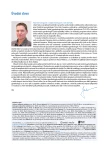The effect of hyaluronate in gynaecology and obstetrics
Authors:
Viktor Križan; Soňa Pánková; Robert Hudeček
Authors‘ workplace:
Gynekologicko-porodnická klinika LF MU a FN Brno
Published in:
Prakt Gyn 2012; 16(1): 7-12
Category:
Gynecology and Obstetrics
Overview
Hyaluronate is a nonsulfated glycosaminoglycan which is the most important component of the intercellular matter. Apart from it creating a sort of scaffolding for cells, it also has the ability to bind water and thus contribute to optimizing of tissue hydration. Hyaluronate is actively involved in the immunological processes as a signal molecule and affects the mobility and adhesion of cells within their proliferation and differentiation. These characteristics are used to speed up the healing and epithelization of injuries and inflammations.
Key words:
adhesion – hyaluronic acid – preoperative adhesion prevention – barriers
Sources
1. Slíva J, Minárik J. Hyaluronát – nejen pasivní pozorovatel, nýbrž aktivní modulátor imunitních reakcí. New EU Magazine of medicine 2009; 1–2: 75–78.
2. Tanimoto K et al. Effects of TGF-beta on hyaluronan anabolism in fibroblasts derived from the synovial membráně of the rabbit temporomandibular point. J Dent Res 2004; 83(1): 40–44.
3. Campo GM et al. Differential effect of growth factors on hyaluronan synthese gene expression in fibroblasts exposed to oxidative stress. Biochemistry 2007; 72(9): 974–982.
4. Yamawakki H et al. Hyaluronan receptors involved in cytokine induction in monocytes. Glycobiology 2009; 19(1): 83–92.
5. Termeer CC et al. Oligosaccharides of hyaluronan are potent activators od dendritic cells. J Immunol 2000; 165(4): 1867–1870.
6. Goldstein NA et al. Wound management of the airway mucosa: comparison with skin in a rabbit model. Int J Pediatr Otorhinolaryngol 1998; 45(3): 223–235.
7. Gerecht S et al. Hyaluronic acid hydrogel for controlled selfrenewal and differentiation of human embryonic stem cells. Proc Natl Acad Sci U.S.A. 2007; 104(27): 11298–11303.
8. Toole BP et al. Hyaluronan and tumor growth. Am J Pathol 2002; 161(3): 745–747.
9. Rooney P, Kumar S, Ponting J, Wang M. The role of hyaluronan in tumour neovascularization (review). International Journal of Cancer 1995; 60(5):632–636.
10. Reijnen M et al. Pathophysiology of intraabdominal adhesion and abscess formation, and the effect of hyaluronan. British Journal of Sugery 2003; 90(5): 533–541.
11. Metwally M, Gorvy D, Watson A et al. Hyaluronic acid for adhesion prevention. Fertil Steril 2007; 87(5): 1139–1146.
12. Goldstein NA et al.Wound management of the airway mucosa: comparison with skin in a rabbit model. Int J Pediatr Otorhinolaryngol 1998; 45(3): 223–235.
13. Reijnen M. et al. Pathophysiology of intraabdominal adhesion and abscess formation, and the effect of hyaluronan. British Journal of Sugery 2003; 90(5): 533–541.
14. Weinberger V, Crha I. Hojení peritonea, tvorba adhezí a možnosti jejich prevence. Prakt Gyn 2005; 9(1): 9–12.
15. Mais V, Cirronis MG, Peiretti M et al. Efficacy of auto-crosslinked hyaluronan gel for adhesion prevention in laparoscopy and hysteroscopy: a systematic review and meta-analysis of randomized controlled trials. Eur J Obstet Gynecol Reprod Biol 2012 Jan; 160(1):1–5.
16. Markowska J, Madry R, Markowska A. The effect of hyaluronic acid (Cicatridine) on healing and regeneration of the uterine cervix and vagina and vulvar dystrophy therapy. Eur J Gynaecol Oncol 2011; 32(1): 65–68.
17. Boselli F, Vezzani C, Chiossi G. Terapia topica con acido ialuronico dopo trattamento electtrochirurgico della cervice uterina. La Colposcopia in Italia 2002; 18(2): 25–28.
18. Tea M, Priemer V, Kubista E. Aktuelles: Wirksamkeit und Sicherheit von Hyaluron-Säure-Zäpfchen (Cikatridina(R)) bei der Behandlung hormon- oder chemotherapieinduzierter vaginaler Atrophie bei Mammakarzinompatientinnen. Journal für Fertilität und Reproduktion 2006; 16(2):17–19.
19. Žáková J et al. Nové metody zvyšující úspěšnost asistované reprodukce. Česká gynekologie 2012; 77(2): 139–141.
Labels
Paediatric gynaecology Gynaecology and obstetrics Reproduction medicineArticle was published in
Practical Gynecology

2012 Issue 1
Most read in this issue
- Mechanism of implantation of the embryo
- Paravaginal hematoma: case report
- Transfer-factor (IMUNOR) administration in women with chronic vulvovaginal discomfort: clinical study results
- Menstrual migraine (migraine without aura): diagnostic and possibility of hormonal treatment
